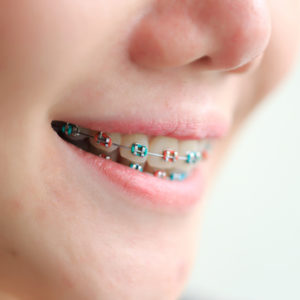 Metal orthodontic braces have traditionally been the method used to straighten teeth in the past. They continue to be a popular method to straighten teeth for teenagers and young adults when the amount of dental crowding or tilting of the teeth is minor or moderate. A small amount of tooth-coloured adhesive is used to stick each orthodontic bracket on each tooth individually. You can also choose from a variety of coloured elastics (called ‘ties’) that are placed around each bracket if you prefer.
Metal orthodontic braces have traditionally been the method used to straighten teeth in the past. They continue to be a popular method to straighten teeth for teenagers and young adults when the amount of dental crowding or tilting of the teeth is minor or moderate. A small amount of tooth-coloured adhesive is used to stick each orthodontic bracket on each tooth individually. You can also choose from a variety of coloured elastics (called ‘ties’) that are placed around each bracket if you prefer.
We will always take a whole-body approach when we consider which methods of teeth straightening are most appropriate for you. What this means is we will always identify the CAUSES of your teeth crowding in order for us to correct them along with giving you straight teeth at the same time. Is this important? The answer is simply without addressing the key reasons why someone has crooked teeth, then there is a real risk that the end result of your orthodontic treatment will be unstable and “relapse”.
Orthodontic relapse is common problem when teeth are straightened unless we identify what the driving forces for the crowded teeth are, which may include:
- Cranial distortions – Cranial osteopaths and chiropractors often identify misalignment or unsymmetrical cranial and facial bones of the head that may be partly responsible for the appearance of your teeth. If these distortions are corrected at the same time then your orthodontic treatment will progress faster and the end result will become more stable.
- Mouth breathing – A person cannot breathe well through their nose, either from allergies or other issues often develops a long face and narrow dental arches as the mouth must be kept open most of the time. These jaw muscles act like orthodontic forces and push the teeth inwards. If we address the breathing issues early and get you breathing through your nose then your orthodontic treatment will be far more successful and stable.
- Bad tongue habits – Did you know that poor tongue swallowing habits can distort your teeth? The most common abnormalities are a forward or lateral “tongue thrust” movement when you swallow. Unless we correct this tongue habit, either before or during orthodontic treatment, then your teeth are likely to pushed out again.
